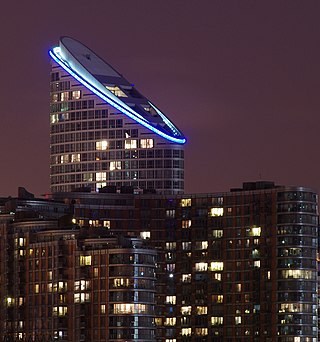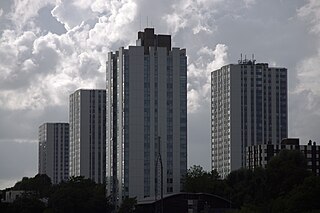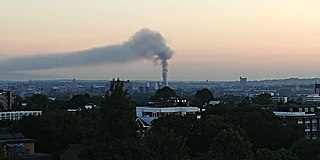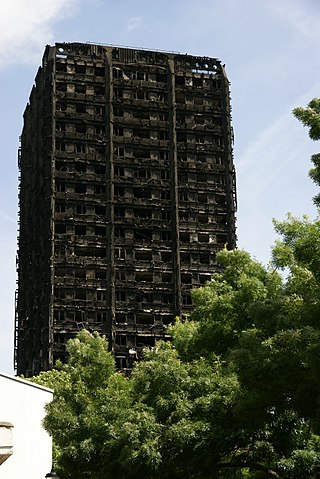
Blackwall is an area of Poplar, in the London Borough of Tower Hamlets, East London. The neighbourhood includes Leamouth and the Coldharbour conservation area.

The Berkeley Group Holdings plc is a British property developer and house-builder based in Cobham, England. It is listed on the London Stock Exchange and is a constituent of the FTSE 100 Index.

The Ontario Tower, located in Blackwall in the former docklands area of east London, is a residential housing block in the New Providence Wharf development on the north side of the River Thames.

Pan Peninsula, also known as 1 Millharbour, is a residential development on the Isle of Dogs, London located near South Quay DLR station. Pan Peninsula is one of several high-rise residential developments that have been constructed on the Isle of Dogs. It was arguably the first “Ultra Luxury” development in Canary Wharf.

Grenfell Centre, formerly known as Oracle House and JLW Building, nicknamed Black Stump, is a high rise office building located at 25 Grenfell Street in the Adelaide city centre, South Australia.

Cladding is the application of one material over another to provide a skin or layer. In construction, cladding is used to provide a degree of thermal insulation and weather resistance, and to improve the appearance of buildings. Cladding can be made of any of a wide range of materials including wood, metal, brick, vinyl, and composite materials that can include aluminium, wood, blends of cement and recycled polystyrene, wheat/rice straw fibres. Rainscreen cladding is a form of weather cladding designed to protect against the elements, but also offers thermal insulation. The cladding does not itself need to be waterproof, merely a control element: it may serve only to direct water or wind safely away in order to control run-off and prevent its infiltration into the building structure. Cladding may also be a control element for noise, either entering or escaping. Cladding can become a fire risk by design or material.

Charrington Tower, originally called Providence Tower, is a 44-storey 136 m (446 ft) residential tower located in the New Providence Wharf development on the north side of the River Thames in the Blackwall area of east London, completed in 2016.

Ballymore Group is an Ireland-based international property development company. The majority of the company's employees and business activities are located in the UK.

On 14 June 2017, a high-rise fire broke out in the 24-storey Grenfell Tower block of flats in North Kensington, West London, at 00:54 BST and burned for 60 hours. 70 people died at the scene, and 2 people died later in hospital, with more than 70 injured and 223 escaping. It was the deadliest structural fire in the United Kingdom since the 1988 Piper Alpha oil-platform disaster and the worst UK residential fire since the Blitz of World War II.

Grenfell Tower is a derelict 24-storey residential tower block in North Kensington in London, England. The tower was completed in 1974 as part of the first phase of the Lancaster West Estate. Most of the tower was destroyed in a severe fire on 14 June 2017.

Tower blocks are high-rise buildings for residential use. These blocks began to be built in Great Britain after the Second World War. The first residential tower block, "The Lawn", was constructed in Harlow, Essex, in 1951; it is now a Grade II listed building. In many cases, tower blocks were seen as a "quick-fix" to cure problems caused by the existence of crumbling and unsanitary 19th-century dwellings or to replace buildings destroyed by German aerial bombing. It was argued that towers surrounded by public open space could provide for the same population density as the terraced housing and small private gardens they replaced, offering larger rooms and improved views, whilst being cheaper to build.

Chalcots Estate is a council housing estate on Adelaide Road and Fellows Road in Swiss Cottage in the London Borough of Camden. It was designed by Dennis Lennon and Partners. The Chalcots Estate was built on land owned by Eton College, which is reflected in the names of the individual buildings.

The Grenfell Tower Inquiry is a British public inquiry into the Grenfell Tower fire, which killed 72 people and destroyed Grenfell Tower on 14 June 2017. It was ordered by Prime Minister Theresa May on the day following the fire.

The Knowsley Heights fire occurred in 1991 at the 11-story Knowsley Heights tower block in Huyton, Merseyside. No-one was injured in the fire.
The Barking fire was a structure fire that occurred on 9 June 2019 at a newly built six storey block of flats named Samuel Garside House, located in De Pass Gardens, Barking, London, the United Kingdom.

On 14 June 2017, the Grenfell Tower fire broke out in the 24-storey Grenfell Tower block of flats in North Kensington, West London, at 00:54 BST; it caused 72 deaths, including those of two victims who later died in hospital. More than 70 others were injured and 223 people escaped. It was the deadliest structural fire in the United Kingdom since the 1988 Piper Alpha disaster and the worst UK residential fire since the Second World War.

The United Kingdom cladding crisis, also known as the cladding scandal, is an ongoing social crisis that followed the Grenfell Tower fire of 14 June 2017 and the Bolton Cube fire of 15 November 2019. The fires revealed that large numbers of buildings had been clad in dangerously combustible materials, comprising a combination of flammable cladding and/or flammable insulation.
The Grenfell Tower Inquiry is a British public inquiry into the Grenfell Tower fire, which killed 72 people and destroyed Grenfell Tower, residential building in the Royal Borough of Kensington and Chelsea, London, on 14 June 2017. It was ordered by Prime Minister Theresa May on the day following the fire.

Criticism of the response to the Grenfell Tower fire primarily consisted of condemnation of issues with the emergency response and fire safety regulation practices in the UK at the time. Broader political criticism was also directed at British society, including condemnation of the response by governmental bodies and UK politicians, social divisions, deregulation issues, and poor transparency overall.

















